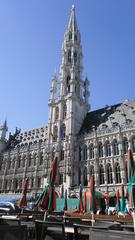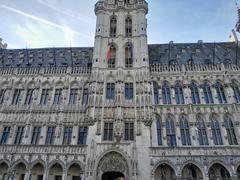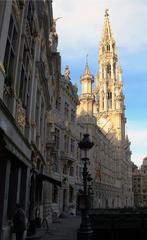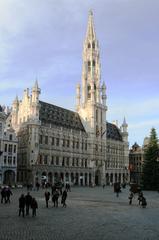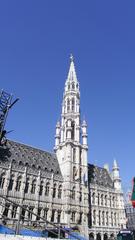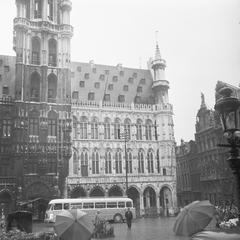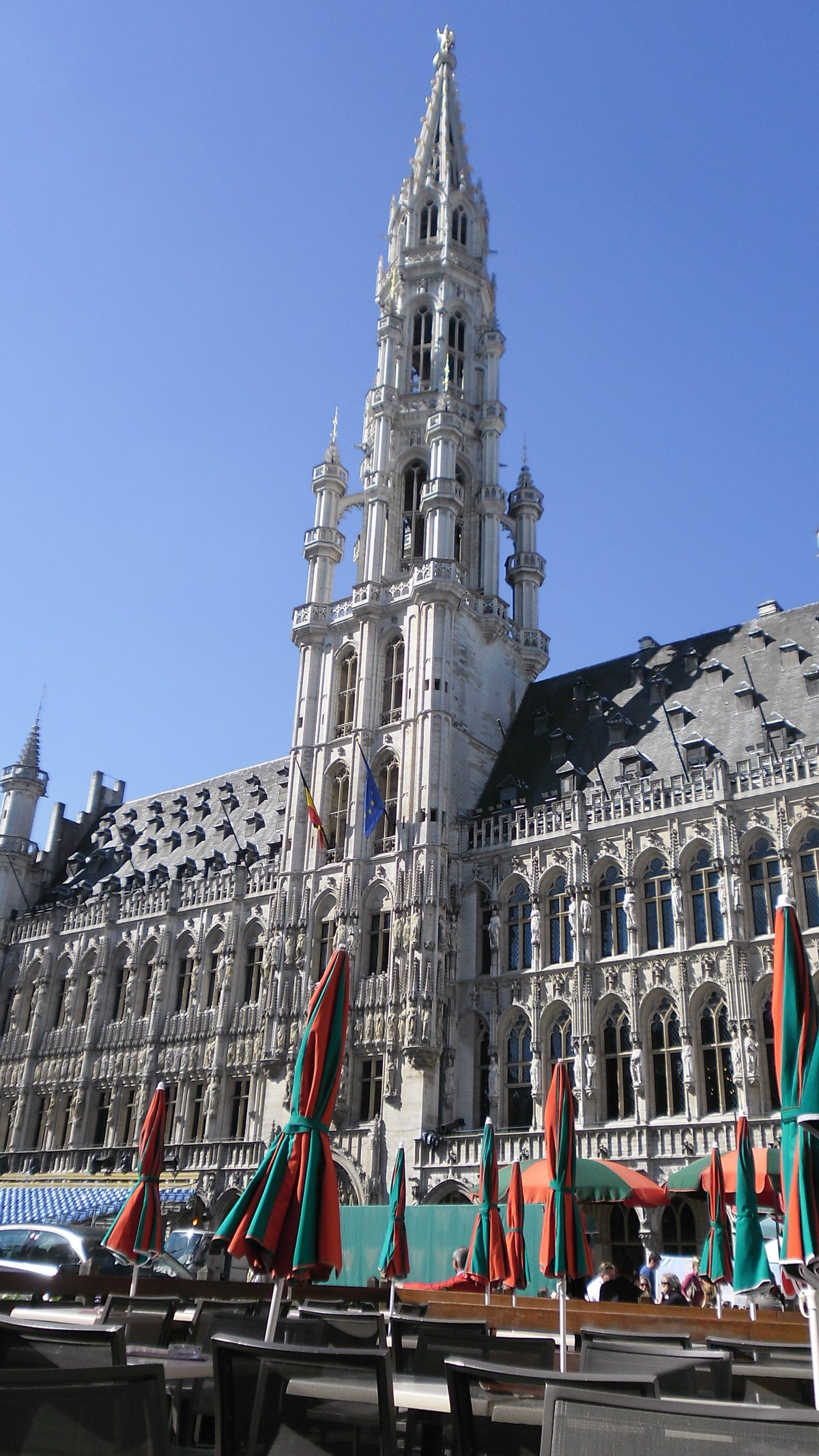
Brussels Town Hall Visiting Hours, Tickets & Historical Significance: Complete Guide
Date: 14/06/2025
Introduction
Brussels Town Hall (Hôtel de Ville/Stadhuis), an architectural jewel at the heart of the UNESCO-listed Grand Place, is a must-visit for anyone exploring Belgium’s capital. This iconic Gothic masterpiece, constructed between 1401 and 1455, boasts a soaring 96-meter tower topped with a gilded statue of Saint Michael, Brussels’ patron saint. With its intricate façade adorned with over 150 sculptures, the Town Hall stands as a testament to Brussels’ medieval prosperity, civic pride, and resilience through centuries of political and cultural change (visit.brussels; Europa.tips; Wikipedia). This guide covers the Town Hall’s history, architectural highlights, cultural significance, visiting hours, ticketing, accessibility, and practical travel tips.
Contents
- Origins and Early Development
- Architectural Evolution
- Exterior Features
- Interior Highlights
- Decorative Arts and Symbolism
- Restoration and Preservation
- Political and Cultural Significance
- Visiting Information
- Hours and Tickets
- Guided Tours and Events
- Accessibility and Travel Tips
- Nearby Attractions
- Notable Historical Events
- Frequently Asked Questions (FAQ)
- Conclusion
Origins and Early Development
The Town Hall’s history begins in the early 15th century, as Brussels emerged as a thriving commercial and political hub in the Duchy of Brabant. The Grand Place evolved from a medieval market into the city’s main square, and the construction of the Town Hall in 1401 signaled Brussels’ ambition for civic autonomy. The original east wing, the only surviving medieval structure on the square, was soon joined by additional wings and the now-iconic tower, completed in 1451, with its gilded Saint Michael statue (theurgetowander.com; art-facts.com).
Architectural Evolution
Exterior Features
Brabantine Gothic Masterpiece
The Town Hall’s asymmetrical façade is characterized by pointed arches, elaborate tracery, and a multitude of sculpted figures—over 150 statues, including saints, nobles, and allegorical representations of civic virtues (Europa.tips). The tower, designed by Jan van Ruysbroeck and completed in 1454, rises 96 meters and is crowned with the gilded figure of Saint Michael slaying a dragon, symbolizing the city’s strength and protection (Introducing Brussels).
Materials and Conservation
Constructed primarily from local white limestone, the building has undergone several restoration campaigns, particularly following the 1695 bombardment that devastated much of the Grand Place (Introducing Brussels; Europa.tips).
Interior Highlights
Gothic Hall
This ceremonial chamber features a vaulted ceiling, slender columns, and stained-glass windows that cast colorful light across tapestries and murals depicting Brussels’ history (Visit Brussels; Europa.tips).
Wedding Hall
Used for civil ceremonies, this ornate room boasts intricate woodwork and period furnishings, blending Gothic and Renaissance influences (Visit Brussels).
Council Chambers
Richly paneled chambers for municipal business display heraldic emblems and portraits, reinforcing the building’s ongoing civic role (Europa.tips).
Tower Ascent
Guided tours allow visitors to climb the spiral staircase for panoramic views over Brussels—a highlight for those able to manage the ascent (Brussels.be).
Decorative Arts and Symbolism
Stained glass windows, heraldic motifs, and finely carved furniture all reinforce the Town Hall’s dual role as a work of art and a symbol of civic identity (Europa.tips; Introducing Brussels).
Restoration and Preservation
The Town Hall narrowly survived the 1695 French bombardment, which destroyed much of the Grand Place but left its main structure standing (art-facts.com). Restoration and Gothic Revival efforts in the 19th century, and its designation as a historic monument in 1936, have ensured its preservation. Since 1998, the Grand Place, with the Town Hall as its centerpiece, has been a UNESCO World Heritage Site (UNESCO; Wikipedia).
Political and Cultural Significance
The Town Hall has long been the seat of Brussels’ municipal government, a symbol of urban autonomy, and the focal point of the city’s political, economic, and cultural life (Wikipedia). It housed the city magistrate and the States of Brabant, and played a pivotal role during the Belgian Revolution of 1830. Today, it hosts official receptions, council meetings, and civic ceremonies, including the biennial Flower Carpet event (State Magazine; Visit Brussels).
Brussels’ multicultural identity is reflected in the Town Hall’s contemporary use for events, festivals, and guided tours, serving both locals and the city’s diverse visitors.
Visiting Information
Visiting Hours
- Tuesday to Sunday: 10:00 AM – 5:00 PM (last entry typically 4:00 PM)
- Closed on Mondays and public holidays
- Hours may vary by season or during special events (Holidify).
Tickets
- Adults: €15
- Seniors (65+): €6
- Children (7–18): €6
- Children under 7: Free
Tickets can be purchased on-site or online via official tourism websites. Booking in advance is recommended, especially for guided tours (MakeMyTrip).
Guided Tours and Special Events
- Guided tours (in multiple languages) provide access to ceremonial rooms and the tower, with rich historical and architectural context.
- Special events: The biennial Flower Carpet, Winter Wonders (Christmas market), and themed exhibitions draw additional visitors (Brussels.be).
Accessibility
- The main entrance and ground floor are wheelchair accessible; upper floors and the tower are not due to historic staircases.
- Visitors with mobility needs should contact visitor services in advance for specific accommodations.
Travel Tips
- Arrive early to avoid crowds, especially during festivals or peak seasons.
- Combine your visit with nearby attractions: Museum of the City of Brussels, Manneken Pis, and local cafés and chocolate shops.
- Dress respectfully if attending official ceremonies.
- Be mindful of the weather—Brussels weather is changeable (Destination Abroad).
Amenities
- Restrooms are available.
- Non-flash photography is generally permitted except in certain rooms or exhibitions.
- Large bags may not be allowed; enquire about storage at the entrance.
Notable Historical Events
- 1401–1455: Construction, marking Brussels’ rise as a major city.
- 1695: Survived the French bombardment—symbol of resilience (art-facts.com).
- 19th-century: Restorations revived the building’s Gothic splendor.
- 1998: Grand Place and Town Hall designated as UNESCO World Heritage (UNESCO).
Frequently Asked Questions (FAQ)
Q: Can I visit without a guided tour?
A: No, most visits are by guided tour to protect the historic interiors.
Q: Are tours available in English?
A: Yes, tours are offered in English and several other languages.
Q: Is the Town Hall accessible for wheelchair users?
A: The ground floor is accessible, but upper floors and the tower have limited access.
Q: Can I take photos inside?
A: Non-flash photography is generally allowed, but some restrictions may apply.
Q: How do I buy tickets?
A: Tickets can be purchased online or at the entrance, but advance booking is advised.
Q: What nearby attractions are recommended?
A: Museum of the City of Brussels, Manneken Pis, the King’s House, and the guildhalls of the Grand Place.
Plan Your Visit: Essential Tips
- Duration: Plan for 1–1.5 hours for the Town Hall, plus time for the Grand Place and adjacent sites (MakeMyTrip).
- Best times: Early morning or late afternoon; evenings for illuminated views (Holidify).
- Safety: The Grand Place is generally safe, but watch for pickpockets during crowded events (Next Stop Belgium).
Visuals and Media Suggestions
- Exterior: “Brussels Town Hall Gothic Facade at Grand Place”
- Interior: “Interior of Brussels Town Hall Council Chamber”
- Tower View: “Panoramic View from Brussels Town Hall Tower”
- Night: “Brussels Town Hall Illuminated at Night”
Consider embedding a map of the Grand Place and providing links to virtual tours for enhanced planning.
Getting There & Amenities
- Access: 5–10 minute walk from Brussels Central Station; Grand Place is well served by metro, tram, and bus.
- Nearby: Cafés, chocolatiers, boutiques, and hotels for all budgets (Holidify).
Conclusion
Brussels Town Hall is a spectacular blend of medieval architecture, civic pride, and living heritage. Its breathtaking façade, rich interiors, and vibrant public role make it an essential stop for anyone visiting Brussels. Check current visiting hours and ticket options, book a guided tour, and allow time to soak in the Grand Place’s atmosphere. For up-to-date information, download the Audiala app, explore our related guides, and follow us on social media.
Sources
- This guide references the following sources for further details and official visitor information:
